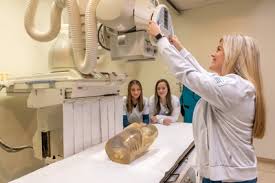Radiologic technology is a field that plays a crucial role in modern healthcare. As a radiologic technologist (also known as a radiographer), you will be responsible for performing diagnostic imaging examinations to help diagnose and treat various medical conditions. This guide aims to provide an in-depth understanding of radiologic tech programs, the skills and knowledge you will gain, and the career opportunities available to you after completing your education.
1. What is a Radiologic Tech Program?
A radiologic tech program is an educational pathway designed to prepare students for a career as radiologic technologists. These programs provide a combination of theoretical knowledge and practical hands-on training in performing imaging procedures, understanding medical terminology, and ensuring patient safety.Radiologic technologists operate imaging equipment, such as X-ray machines, CT scanners, and MRI machines, to capture images of patients’ internal structures. This crucial role in the healthcare team aids physicians in diagnosing and treating medical conditions. Radiologic tech programs are typically offered at community colleges, universities, and technical schools, leading to an associate’s or bachelor’s degree.
2. Types of Radiologic Tech Programs
Radiologic tech programs vary in length, level, and focus. Here are the most common types:
- Associate Degree Programs: These are the most prevalent and typically take about two years to complete. They provide the foundational knowledge and skills required for entry-level positions in the field.
- Bachelor’s Degree Programs: Lasting approximately four years, these programs offer a more in-depth education, including advanced imaging techniques and management courses. Graduates may have better job prospects and potential for higher salaries.
- Certificate Programs: For individuals who already hold a degree in a related field or for practicing professionals looking to expand their skill set, certificate programs focus on specific imaging modalities, such as MRI or ultrasound.
- Online Programs: Many institutions now offer online radiologic tech programs, which provide flexibility for students. However, practical components still require on-site clinical training.
3. Curriculum Overview
The curriculum for a radiologic tech program is designed to provide a comprehensive education that combines classroom learning with practical experience. Key subjects typically include:
- Radiographic Procedures: Students learn about various imaging techniques, positioning, and equipment operation.
- Anatomy and Physiology: A solid understanding of human anatomy and physiology is crucial for accurately imaging and interpreting results.
- Radiation Physics and Safety: This includes the principles of radiation, the biological effects of radiation exposure, and safety protocols to protect patients and staff.
- Patient Care: Students are trained in effective communication, patient assessment, and emergency response.
- Clinical Practicum: Hands-on experience in a clinical setting is essential. Students work under the supervision of licensed technologists to gain real-world experience.
Example Curriculum Structure
| Semester | Courses |
|---|---|
| 1 | Introduction to Radiologic Technology |
| 2 | Anatomy & Physiology, Patient Care |
| 3 | Radiographic Procedures, Imaging Physics |
| 4 | Clinical Practicum I |
| 5 | Advanced Imaging Techniques, Ethics |
| 6 | Clinical Practicum II |
4. Skills and Competencies Developed
Radiologic tech programs equip students with a variety of skills and competencies necessary for success in the field. Key skills include:
- Technical Proficiency: Mastering the operation of various imaging equipment and understanding the technical aspects of each modality.
- Attention to Detail: Radiologic technologists must pay close attention to detail to ensure accurate images and proper patient positioning.
- Communication Skills: Effective communication is essential for explaining procedures to patients and collaborating with healthcare team members.
- Critical Thinking: The ability to analyze situations and make informed decisions is vital, especially in emergency circumstances.
- Compassion and Empathy: Working closely with patients requires a compassionate approach to ensure their comfort and understanding.
5. Accreditation and Certification
Choosing an accredited radiologic tech program is essential, as accreditation ensures that the program meets established standards of quality and rigor. Accreditation is typically granted by organizations such as the Joint Review Committee on Education in Radiologic Technology (JRCERT).After completing an accredited program, graduates are eligible to take the certification exam administered by the American Registry of Radiologic Technologists (ARRT). Certification is often required for employment and demonstrates a commitment to professionalism and ongoing education.
Steps to Certification
- Complete an accredited radiologic tech program.
- Apply for the ARRT certification examination.
- Pass the examination to become a registered radiologic technologist (RT).
6. Career Opportunities in Radiologic Technology
Radiologic technology offers a diverse range of career opportunities. While many radiologic technologists work in hospitals, there are also positions available in outpatient clinics, imaging centers, and research facilities. Some possible career paths include:
- Radiologic Technologist: The most common role, performing imaging procedures and ensuring patient safety.
- MRI Technologist: Specializing in magnetic resonance imaging, MRI technologists operate MRI machines to produce detailed images.
- CT Technologist: Focused on computed tomography, these technologists perform CT scans to create cross-sectional images of the body.
- Radiation Therapist: Working primarily in cancer treatment, radiation therapists administer targeted radiation to patients.
- Sonographer: Also known as ultrasound technologists, sonographers use high-frequency sound waves to create images of organs and tissues.
Job Outlook and Salary
According to the U.S. Bureau of Labor Statistics (BLS), employment for radiologic technologists is projected to grow by 7% from 2021 to 2031, faster than the average for all occupations. As of May 2022, the median annual wage for radiologic technologists was $61,900.
7. The Future of Radiologic Technology
The field of radiologic technology is continuously evolving, driven by advancements in technology and changes in healthcare practices. Notable trends include:
- Emerging Imaging Modalities: Innovations such as 3D mammography and digital imaging are becoming more prevalent, requiring technologists to stay updated on new techniques.
- Telemedicine: The rise of telehealth has created opportunities for remote imaging consultations and interpretations, expanding the roles of radiologic technologists.
- Artificial Intelligence: AI is increasingly being integrated into imaging technology, assisting in diagnostics and workflow efficiency. Radiologic technologists will need to adapt to these advancements.
- Interdisciplinary Collaboration: As healthcare becomes more integrated, radiologic technologists will work closely with other healthcare professionals to enhance patient care.
8. Conclusion
Radiologic tech programs provide a solid foundation for a rewarding career in healthcare. As a radiologic technologist, you will play a vital role in patient care, utilizing advanced imaging technology to aid in diagnosis and treatment. With a variety of career paths available and a promising job outlook, pursuing a radiologic tech program is an excellent choice for those interested in making a difference in the healthcare field.
9. Frequently Asked Questions (FAQs)
Q1: How long does it take to complete a radiologic tech program?
A1: Most associate degree programs take two years, while bachelor’s degree programs take about four years. Certificate programs vary in length depending on the specific focus.Q2: Is certification necessary to work as a radiologic technologist?
A2: While certification is not always legally required, most employers prefer or require candidates to be certified by the ARRT.Q3: Are there online options for radiologic tech programs?
A3: Yes, many institutions now offer online radiologic tech programs, though clinical training must be completed in-person.Q4: What is the job outlook for radiologic technologists?
A4: The job outlook is positive, with a projected growth rate of 7% from 2021 to 2031, according to the BLS.Q5: What kind of skills do I need to succeed in this field?
A5: Key skills include technical proficiency, attention to detail, communication skills, critical thinking, and compassion for patients.With this comprehensive guide, aspiring radiologic technologists can better understand the path ahead, making informed decisions about their education and career choices in this vital healthcare field.



